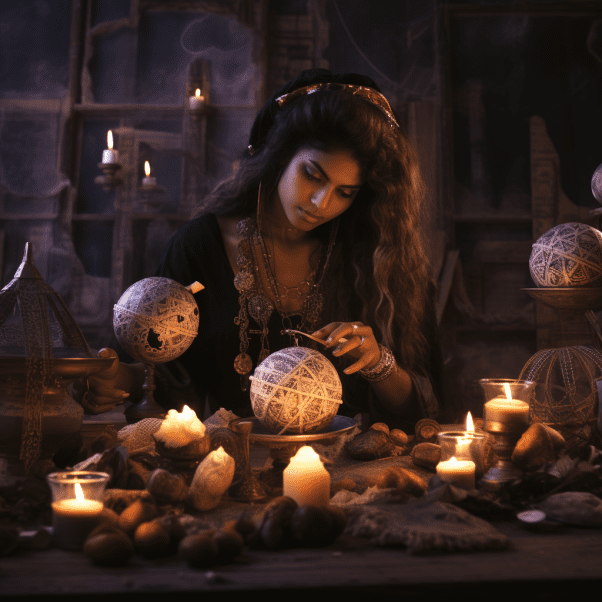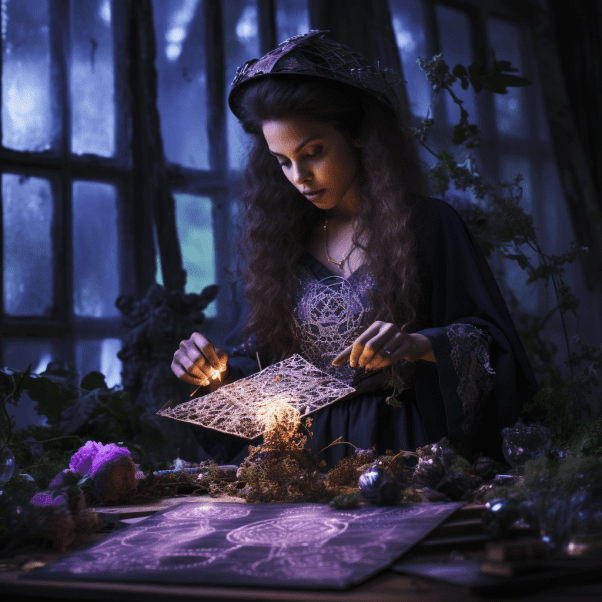Welcome to the enchanted realm of spellcrafting! Whether you’re a seasoned practitioner of the arcane arts or someone who’s just beginning to explore the possibilities that magic has to offer, crafting your own spells is a deeply personal and profoundly empowering journey. Here, we embark on a beginner’s guide to spellcrafting, a path that allows you to tap into your inner power and the energies of the universe to manifest positive change.
Discovering the Essence of Spellcrafting
At its core, spellcrafting is the art of aligning your intentions with the natural rhythms of the world to bring about a desired outcome. It’s a creative process that combines willpower, visualization, elements of nature, and personal symbolism to form a tapestry of transformation.
Setting Your Intention in Spellcrafting
Before you begin, understand that the most potent spells are those crafted with a clear and focused intention. What do you wish to attract or repel in your life? Whether it’s love, protection, abundance, or peace, your intention is the seed from which the spell grows. Hold it in your mind, nurture it in your heart, and ready it for planting.
Aligning with Natural Rhythms
The world around us is a dance of cycles and seasons, from the moon’s waxing and waning to the earth’s rotation through phases of growth, harvest, decay, and rebirth. To craft a spell is to tap into this natural ebb and flow, timing your actions to harmonize with these powerful forces. A spell cast under the new moon, for instance, can harness the energy of beginnings for spells related to new ventures or fresh starts. Conversely, the full moon illuminates and energizes intentions, making it ideal for spells of manifestation and culmination.
The Creative Process of Spellcrafting
Spellcrafting is akin to an art form. Just as a painter wields brush and palette to bring a vision to life, the spellcrafter uses willpower, visualization, and symbolic materials to weave their intention into being. This creative process is deeply personal. It may involve writing a clear statement of intent, creating a sigil that embodies your desire, or even composing a song or chant that resonates with your goal. There is no one-size-fits-all approach; your spell is a unique creation that speaks the language of your soul.
Combining Willpower and Visualization
Willpower is the driving force behind your spell. It’s your determination and resolve that fuels the transformation you seek. When combined with visualization, which is the act of creating a vivid mental image of your desired outcome, you generate a potent energetic blueprint. This blueprint is what you imprint upon the universe, a clear and focused request for a specific change or result.
Elements of Nature in Spellcrafting
Incorporating elements of nature into your spellcraft anchors your intention in the physical world. Each element — be it earth, air, fire, water, or spirit — carries its own energetic signature and can be used to bolster specific aspects of your spell. Fire might be harnessed to ignite passion or facilitate change, while water could be used for purification or emotional healing. Crystals, herbs, and other natural objects not only lend their energies but also serve as physical representations of your intention, strengthening the connection between thought and reality.
Personal Symbolism
Symbols are the language through which the subconscious speaks, and in spellcraft, they serve as powerful catalysts for change. By incorporating symbols that hold personal significance — perhaps a locket for love spells, or a key for opening new pathways — you’re enlisting the deepest parts of your psyche in the service of your spell. These symbols become touchstones of your intention, focal points that keep the spell alive in your mind and heart.
The Tapestry of Transformation inSpellcrafting
Every spell is a thread in the fabric of existence. With every intention set, every word spoken, and every symbol activated, you are contributing to an ever-shifting pattern. This tapestry is not static; it is a living, breathing manifestation of will and desire, affected by the weavings of others and the movements of the cosmos itself. Spellcrafting is, therefore, both an act of personal empowerment and a dialogue with the universe — a cooperative dance where the outcomes may surprise and delight, as the world responds in its own mysterious ways.
Approached with respect, intention, and an open heart, spellcrafting becomes more than just a practice — it’s a transformative journey that intertwines the magic within you to the endless magic that surrounds you.

Gathering Your Tools for Spellcrafting
Spellcraft doesn’t require elaborate tools, but having a few basics can help channel and amplify your energies. Consider incorporating:
- Candles: Different colors can correspond to various intentions (e.g., green for growth, red for passion).
- Crystals and Stones: Natural amplifiers of energy, each with unique properties.
- Herbs: From sage for cleansing to lavender for relaxation, herbs are powerful allies.
- Symbols: Personal tokens that represent your intention.
- Words: Affirmations, poetry, or ancient incantations that resonate with your goal.
Remember, the most powerful tool in spellcrafting is your own spirit. Tools are just extensions of the energy you already possess.
Candles in Spellcrafting
Candles are a staple in spellcraft for their ability to represent the element of fire, symbolizing transformation, life, and will. The act of lighting a candle signifies the ignition of your intent into the physical world. Different colors enhance specific vibrations:
- Green: Used for prosperity, abundance, and growth spells.
- Red: Invokes passion, courage, and vitality.
- Blue: Can be used for healing, tranquility, and understanding.
- Yellow: Represents intellect, creativity, and confidence.
- Purple: Helps in deepening spiritual awareness and psychic abilities.
- Black: Useful for protection, banishing, and breaking free of negative influences.
- White: A universal candle that can be charged with any intention, representing purity and truth.
The flame itself becomes a focal point for concentration, a miniature beacon that casts light on your desires. As the candle burns, it releases your intention into the universe.
Crystals and Stones
Each crystal or stone carries its own energetic frequency and can be selected to match the vibration of your intention:
- Clear Quartz: Known as the ‘master healer,’ it can amplify the energy of other stones and intentions.
- Amethyst: Promotes spiritual wisdom and guards against negative thoughts.
- Rose Quartz: Opens the heart to love, compassion, and emotional healing.
- Citrine: Attracts joy, wealth, and success.
- Black Tourmaline: Offers powerful protection and grounding.
When using crystals in spells, you can place them on your altar, hold them in your hands during meditation, or carry them as talismans to continuously resonate with the energy of your spell.
Herbs
Herbs have been used for centuries for their medicinal and magical properties. Each has its own unique signature that can be harnessed:
- Sage: Used for purification and to clear negative energies.
- Lavender: Encourages calmness, peace, and restful sleep.
- Mint: Attracts prosperity and increases mental alertness.
- Rosemary: Enhances memory and is used in protection spells.
- Basil: Draws in love and happiness.
Herbs can be used in a variety of ways, from burning them as incense to infusing them in oils, to including them in charm bags.
Symbols in Spellcrafting
Symbols act as physical manifestations of your thoughts and intentions and serve as powerful tools for focus and manifestation. They could be anything from a piece of jewelry to a drawn image or a found object that holds personal meaning. When choosing a symbol, consider what instinctively feels right and what visually represents your goal.
Words
The words you choose are the verbal expression of your intent. This could be in the form of:
- Affirmations: Positive, present-tense statements that assert your intention as reality.
- Poetry: The rhythmic quality of poetry can raise energy and encapsulate complex emotions and intentions.
- Incantations: These can be traditional or self-composed, and they’re often used to raise energy and focus the mind.
- Mantras: Repetitive sounds or phrases that help in meditation and concentration.
Words can be spoken aloud, whispered, written down, or even repeated mentally. They serve as a direct communication with your subconscious mind and the universe, reinforcing the energy of your intention.
Integrating Your Tools into Spellcrafting
When you integrate these tools into your spell, you’re layering multiple dimensions of symbolic and energetic resonance, creating a more complex and nuanced vibrational signature. It’s like an orchestra where each instrument plays a role in the overall symphony; each tool contributes its unique energy to the casting of your spell.

Remember the Core
In the end, remember that these tools serve to support the innate power of your spirit. Your will, focus, and intent are the true forces behind your spell. The tools are conduits and amplifiers, but the real magic always begins with you. With clear intent and an open heart, even the simplest spell can weave profound changes into the fabric of the universe.
Spellcrafting: Crafting Your Ritual
- Create a Sacred Space: Find a quiet spot where you won’t be disturbed. Cleanse it with smoke from sage or palo santo, or with the sound of bells or chimes.
- Cast a Circle: Envision a protective boundary around your space, sealing it with light and intent.
- Invoke Elements: Call upon the elements or any deities you feel aligned with to assist in your work.
- Raise Energy: Through dance, drumming, chanting, or simply deep breathing, build the energy you’ll direct into your spell.
- Perform the Spell: Combine your tools and intention, focusing deeply on the desired outcome. Visualize it as vividly as possible.
- Seal the Spell: Close your ritual by thanking any energies or deities you invoked, imagining your wish being carried out into the universe.
- Ground Yourself: Release any excess energy by visualizing it returning to the earth. Eat or drink something to help bring you back to the present moment.
Creating and performing a ritual is an intimate and sacred process. It’s a choreographed spiritual event that aligns personal intention with the universal energies. Here’s a deeper exploration of each step to guide you through crafting a ritual that resonates with your inner being and the external forces at play.
Creating a Sacred Space
- Location: Whether indoors or out in nature, the space should feel safe and hold significance for your work. If indoors, consider the lighting, temperature, and seating arrangements.
- Cleansing: Use traditional smudging herbs like sage to cleanse the space energetically. If smoke is not preferred, sound vibrations from bells or chimes can also clear the area. Some may use saltwater or crystals with cleansing properties like selenite.
- Personalization: Adorn your space with items that hold personal value—photographs, heirlooms, favorite textiles—to enhance your connection to the work.
Casting a Circle
- Intention: As you cast your circle, do so with a clear intention of what you are protecting yourself from and what you are containing within the space.
- Visualization: Use all your senses to envision the circle. Some may see it as a beam of light, others as a ring of fire or a boundary of water. The more vivid the visualization, the stronger the boundary.
- Physical Representation: Optionally, you can lay out stones, crystals, or cords in a circle to give a physical form to your protective barrier.
Invoking Elements and Deities
- Elements: Calling the elements involves acknowledging their presence and inviting their essence into your space—north for earth, east for air, south for fire, and west for water.
- Deities: If you work with specific gods, goddesses, or spiritual guides, invite them with respect and clarity. State your intentions and ask for their support.
- Ancestral Help: Some may also call upon their ancestors or loved ones who have passed on for guidance and support.
Raising Energy
- Movement: Dance and movement are primal and potent ways to raise energy. Let your body move freely, intuitively, and rhythmically.
- Sound: Drumming has a heartbeat-like quality that aligns with the core of living things; it can be powerful in energy work. Chanting or toning can also resonate within the body and space, amplifying intent.
- Breathwork: Deep, controlled breathing is perhaps the most accessible form of raising energy. It can also be combined with visualization techniques.
Performing the Spell
- Focus: The core of the spell is your intention. Concentrate fully on the desired outcome, using all tools at your disposal—candles for focus, crystals for amplification, herbs for their energies, symbols for archetypal power, and words for structure and vibration.
- Action: Perform the physical components of your spell, be it tying knots, anointing candles, grinding herbs, or setting out crystals. Let your actions be deliberate and mindful.
- Visualization: Imagine the outcome of your spell in as much detail as possible. Engage all your senses in this visualization to give it depth and strength.

Sealing the Spell
- Gratitude: Always thank the elements, deities, and any other energies you’ve invoked. Acknowledging their assistance is crucial in maintaining a respectful relationship with these forces.
- Release: Envision your intentions moving beyond your circle, out into the universe where they can manifest. Some may visualize their circle opening or energy dispersing.
- Closing Statement: End with a statement that signifies the end of the work, such as “So mote it be,” “It is done,” or simply “Thank you.”
Grounding Yourself
- Energy Release: Sit on the ground, touch the earth, or hold a grounding stone like hematite or obsidian to dispel any excess energy.
- Eating and Drinking: Consume a light snack or some water. This act brings you back into your body and signals to your mind that the ritual work is complete.
- Reflection: Take a moment to journal or reflect on the experience. Note any feelings, sensations, or thoughts that arose during the ritual.
By expanding on these foundational elements of ritual crafting, you create a structured yet deeply personal magical practice. Remember, the power of a ritual lies as much in the sincerity and clarity of your intention as it does in the ceremonial acts themselves. Each step is a building block, not just in the ritual at hand, but in your broader spiritual journey.
After the Spell
Once your spell is cast, trust that the universe will take care of the details. The magic you’ve woven is now part of the tapestry of reality, and it will unfold as it should. Be patient, be observant, and be open to the ways in which your spell may manifest.
The Ethical Weaver
Always approach spellcraft with respect and never attempt to impose your will on another or to cause harm. The essence of true magic lies in harmony with the world, not in dominion over it. As the Wiccan Rede wisely advises, “An it harm none, do what ye will.”
Embracing the Journey
Spellcrafting is a skill that grows with practice and intuition. Each spell you craft teaches you more about yourself and the universe. Remember, every successful spell begins with a belief in yourself and in the possibility of magic.
As you step forward on this enchanting path, may your spirit shine brightly, your intentions manifest purely, and your life be filled with the magic you create. Welcome to the world of spellcrafting—may it be a transformative element in your journey of growth and discovery. 🌟
